COIT20248: Information Systems Analysis & Design - HIS Project Report
VerifiedAdded on 2023/02/01
|17
|2876
|68
Report
AI Summary
This report presents an analysis and design plan for a Hospital Information System (HIS), developed to manage patient information, appointments, prescriptions, and pharmacy orders. It begins by identifying the Prototyping Approach as the most suitable system development methodology for this project. The report then details both functional and non-functional system requirements, encompassing electronic medical records, patient-doctor profiles, medicine inventory management, and security measures. A thorough cost-benefit analysis is conducted, demonstrating a positive Net Present Value (NPV) and a Return on Investment (ROI) of 14%, indicating the project's financial feasibility. A comprehensive Work Breakdown Structure (WBS) and a Gantt chart are provided to outline the project schedule, activities, and timelines, detailing initiation, planning, execution, and closing phases. Finally, the report discusses system information requirement investigation techniques, including interviews with doctors and nurses, patient feedback, and system documentation review, to ensure a comprehensive understanding of stakeholder needs. The report concludes that the project is feasible and well-planned, with strong emphasis on its financial viability and stakeholder involvement.
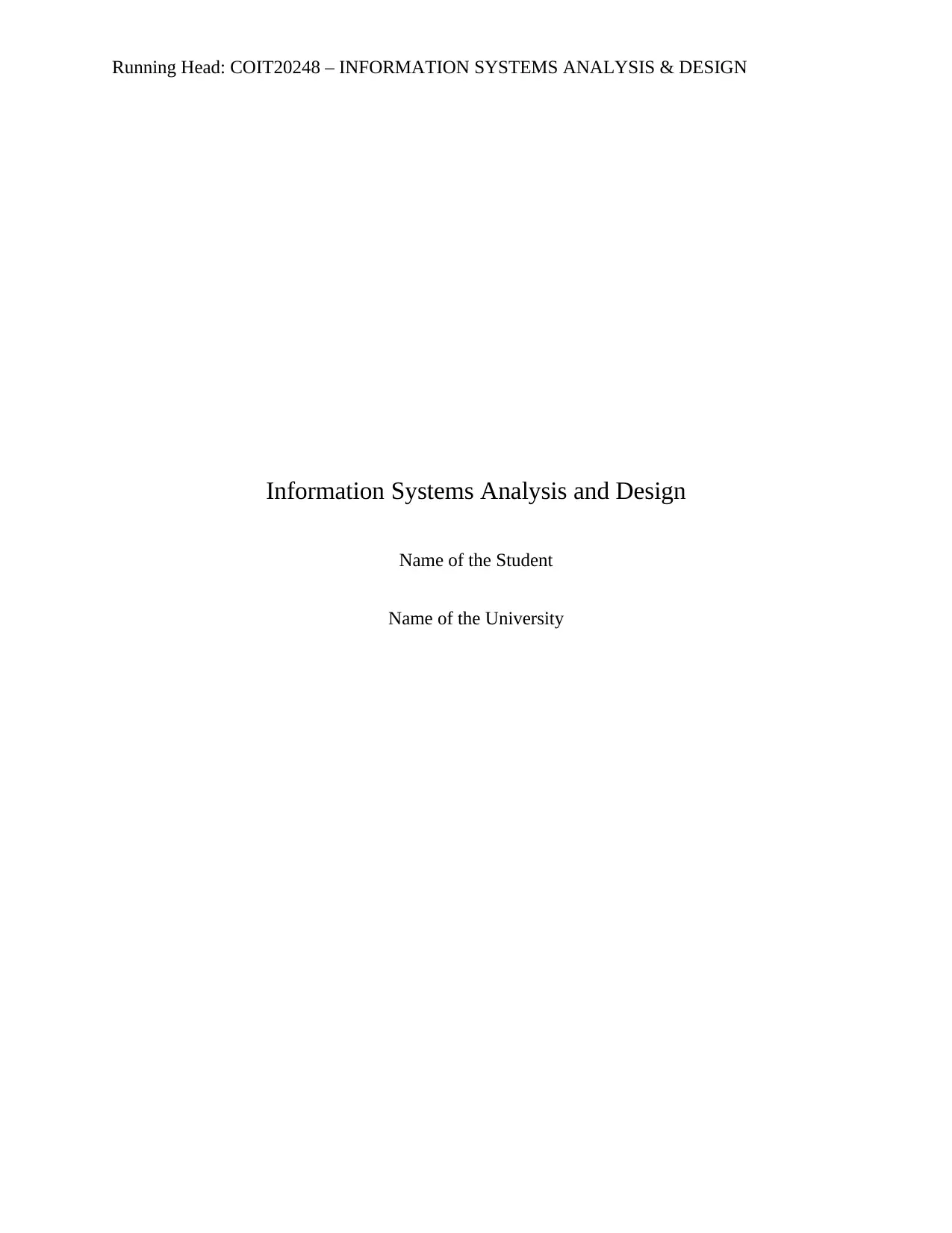
Running Head: COIT20248 – INFORMATION SYSTEMS ANALYSIS & DESIGN
Information Systems Analysis and Design
Name of the Student
Name of the University
Information Systems Analysis and Design
Name of the Student
Name of the University
Paraphrase This Document
Need a fresh take? Get an instant paraphrase of this document with our AI Paraphraser
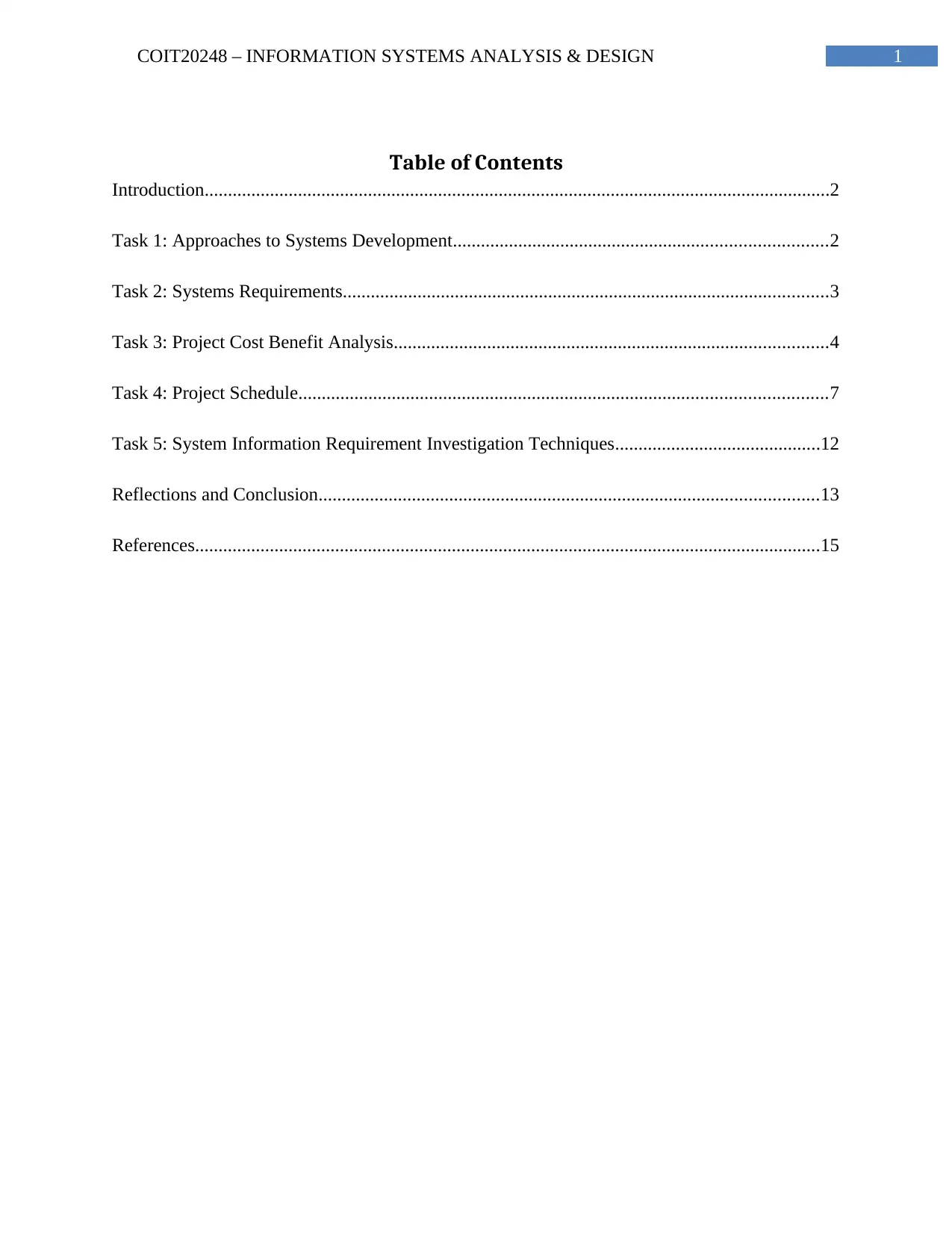
1COIT20248 – INFORMATION SYSTEMS ANALYSIS & DESIGN
Table of Contents
Introduction......................................................................................................................................2
Task 1: Approaches to Systems Development................................................................................2
Task 2: Systems Requirements........................................................................................................3
Task 3: Project Cost Benefit Analysis.............................................................................................4
Task 4: Project Schedule.................................................................................................................7
Task 5: System Information Requirement Investigation Techniques............................................12
Reflections and Conclusion...........................................................................................................13
References......................................................................................................................................15
Table of Contents
Introduction......................................................................................................................................2
Task 1: Approaches to Systems Development................................................................................2
Task 2: Systems Requirements........................................................................................................3
Task 3: Project Cost Benefit Analysis.............................................................................................4
Task 4: Project Schedule.................................................................................................................7
Task 5: System Information Requirement Investigation Techniques............................................12
Reflections and Conclusion...........................................................................................................13
References......................................................................................................................................15
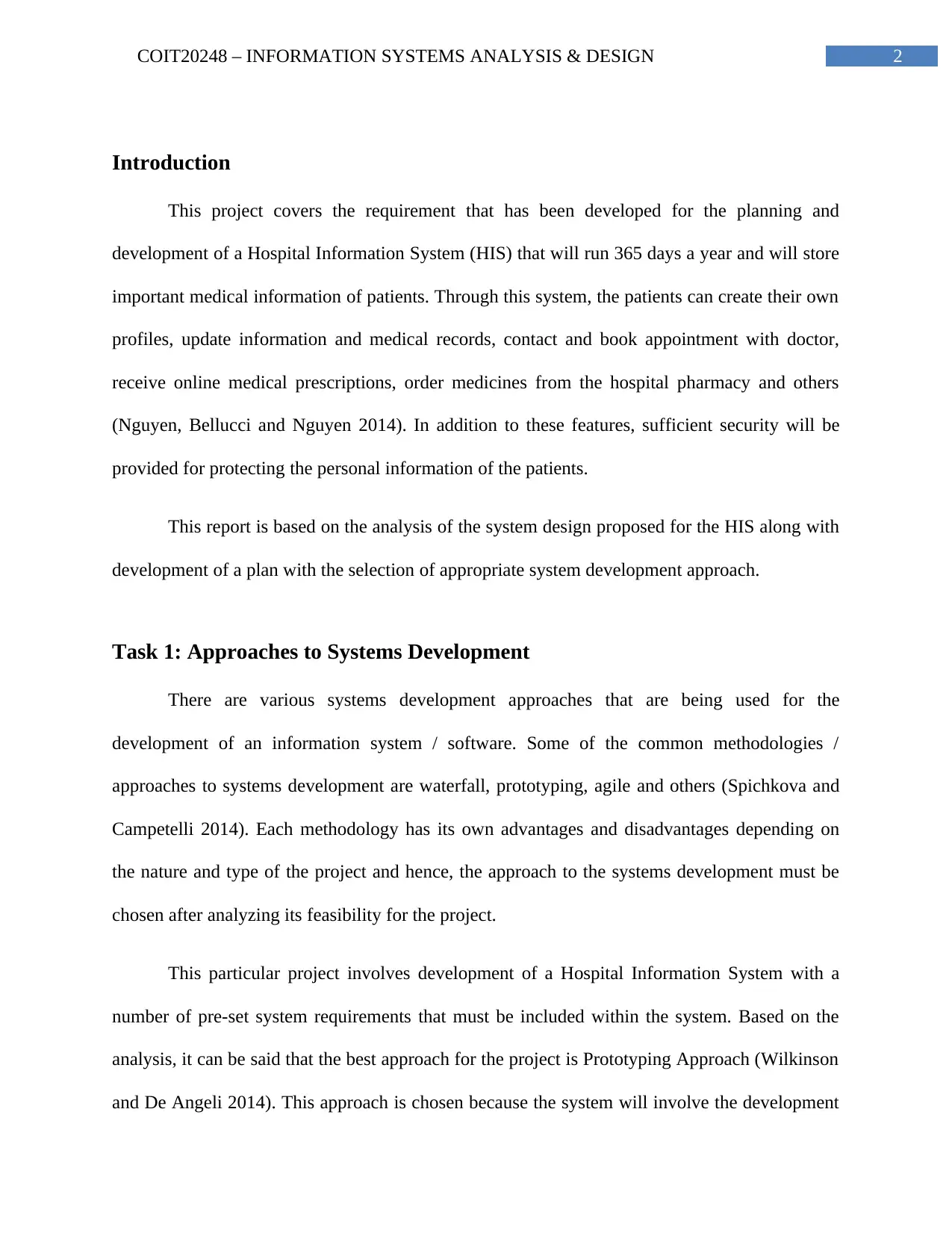
2COIT20248 – INFORMATION SYSTEMS ANALYSIS & DESIGN
Introduction
This project covers the requirement that has been developed for the planning and
development of a Hospital Information System (HIS) that will run 365 days a year and will store
important medical information of patients. Through this system, the patients can create their own
profiles, update information and medical records, contact and book appointment with doctor,
receive online medical prescriptions, order medicines from the hospital pharmacy and others
(Nguyen, Bellucci and Nguyen 2014). In addition to these features, sufficient security will be
provided for protecting the personal information of the patients.
This report is based on the analysis of the system design proposed for the HIS along with
development of a plan with the selection of appropriate system development approach.
Task 1: Approaches to Systems Development
There are various systems development approaches that are being used for the
development of an information system / software. Some of the common methodologies /
approaches to systems development are waterfall, prototyping, agile and others (Spichkova and
Campetelli 2014). Each methodology has its own advantages and disadvantages depending on
the nature and type of the project and hence, the approach to the systems development must be
chosen after analyzing its feasibility for the project.
This particular project involves development of a Hospital Information System with a
number of pre-set system requirements that must be included within the system. Based on the
analysis, it can be said that the best approach for the project is Prototyping Approach (Wilkinson
and De Angeli 2014). This approach is chosen because the system will involve the development
Introduction
This project covers the requirement that has been developed for the planning and
development of a Hospital Information System (HIS) that will run 365 days a year and will store
important medical information of patients. Through this system, the patients can create their own
profiles, update information and medical records, contact and book appointment with doctor,
receive online medical prescriptions, order medicines from the hospital pharmacy and others
(Nguyen, Bellucci and Nguyen 2014). In addition to these features, sufficient security will be
provided for protecting the personal information of the patients.
This report is based on the analysis of the system design proposed for the HIS along with
development of a plan with the selection of appropriate system development approach.
Task 1: Approaches to Systems Development
There are various systems development approaches that are being used for the
development of an information system / software. Some of the common methodologies /
approaches to systems development are waterfall, prototyping, agile and others (Spichkova and
Campetelli 2014). Each methodology has its own advantages and disadvantages depending on
the nature and type of the project and hence, the approach to the systems development must be
chosen after analyzing its feasibility for the project.
This particular project involves development of a Hospital Information System with a
number of pre-set system requirements that must be included within the system. Based on the
analysis, it can be said that the best approach for the project is Prototyping Approach (Wilkinson
and De Angeli 2014). This approach is chosen because the system will involve the development
⊘ This is a preview!⊘
Do you want full access?
Subscribe today to unlock all pages.

Trusted by 1+ million students worldwide
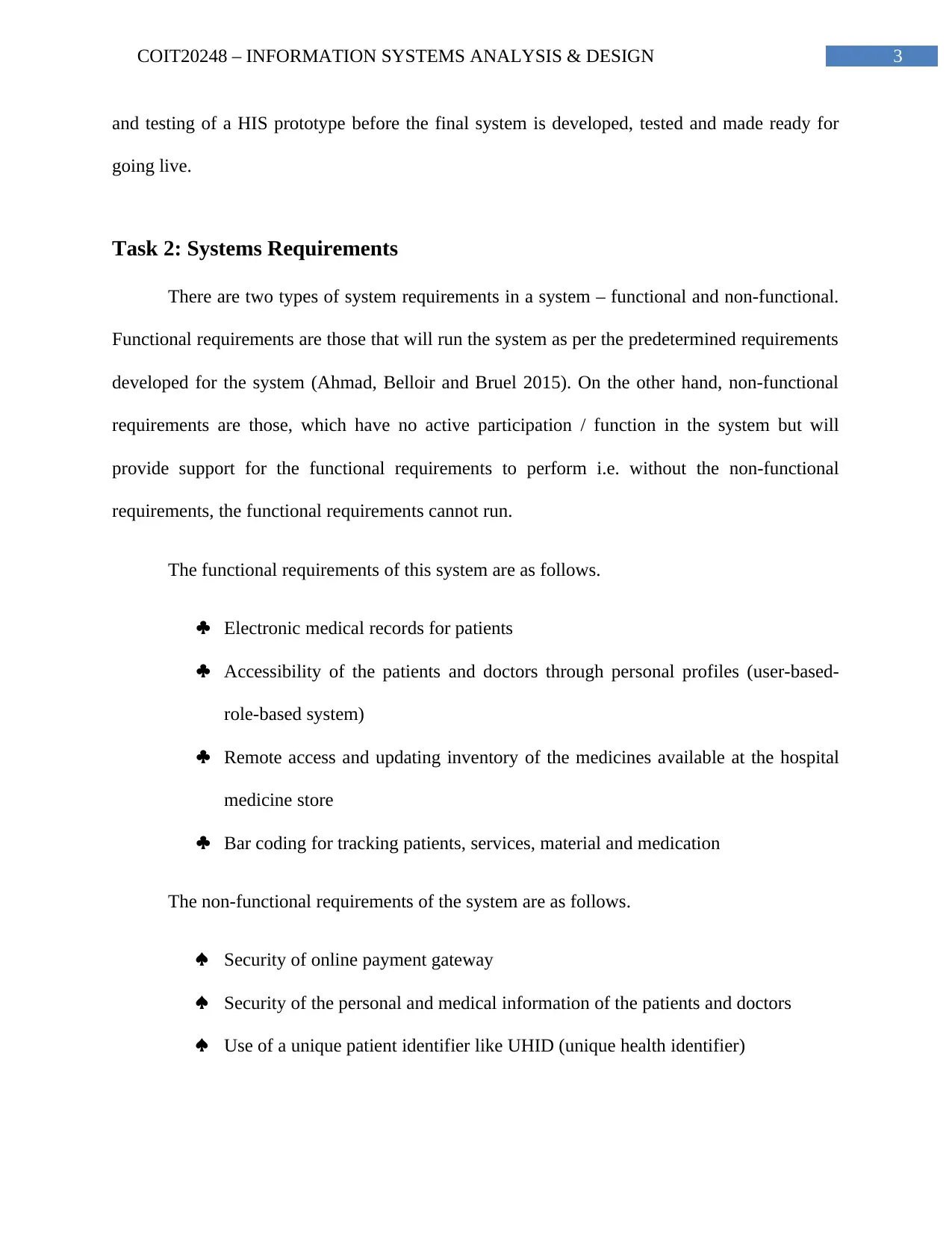
3COIT20248 – INFORMATION SYSTEMS ANALYSIS & DESIGN
and testing of a HIS prototype before the final system is developed, tested and made ready for
going live.
Task 2: Systems Requirements
There are two types of system requirements in a system – functional and non-functional.
Functional requirements are those that will run the system as per the predetermined requirements
developed for the system (Ahmad, Belloir and Bruel 2015). On the other hand, non-functional
requirements are those, which have no active participation / function in the system but will
provide support for the functional requirements to perform i.e. without the non-functional
requirements, the functional requirements cannot run.
The functional requirements of this system are as follows.
Electronic medical records for patients
Accessibility of the patients and doctors through personal profiles (user-based-
role-based system)
Remote access and updating inventory of the medicines available at the hospital
medicine store
Bar coding for tracking patients, services, material and medication
The non-functional requirements of the system are as follows.
Security of online payment gateway
Security of the personal and medical information of the patients and doctors
Use of a unique patient identifier like UHID (unique health identifier)
and testing of a HIS prototype before the final system is developed, tested and made ready for
going live.
Task 2: Systems Requirements
There are two types of system requirements in a system – functional and non-functional.
Functional requirements are those that will run the system as per the predetermined requirements
developed for the system (Ahmad, Belloir and Bruel 2015). On the other hand, non-functional
requirements are those, which have no active participation / function in the system but will
provide support for the functional requirements to perform i.e. without the non-functional
requirements, the functional requirements cannot run.
The functional requirements of this system are as follows.
Electronic medical records for patients
Accessibility of the patients and doctors through personal profiles (user-based-
role-based system)
Remote access and updating inventory of the medicines available at the hospital
medicine store
Bar coding for tracking patients, services, material and medication
The non-functional requirements of the system are as follows.
Security of online payment gateway
Security of the personal and medical information of the patients and doctors
Use of a unique patient identifier like UHID (unique health identifier)
Paraphrase This Document
Need a fresh take? Get an instant paraphrase of this document with our AI Paraphraser
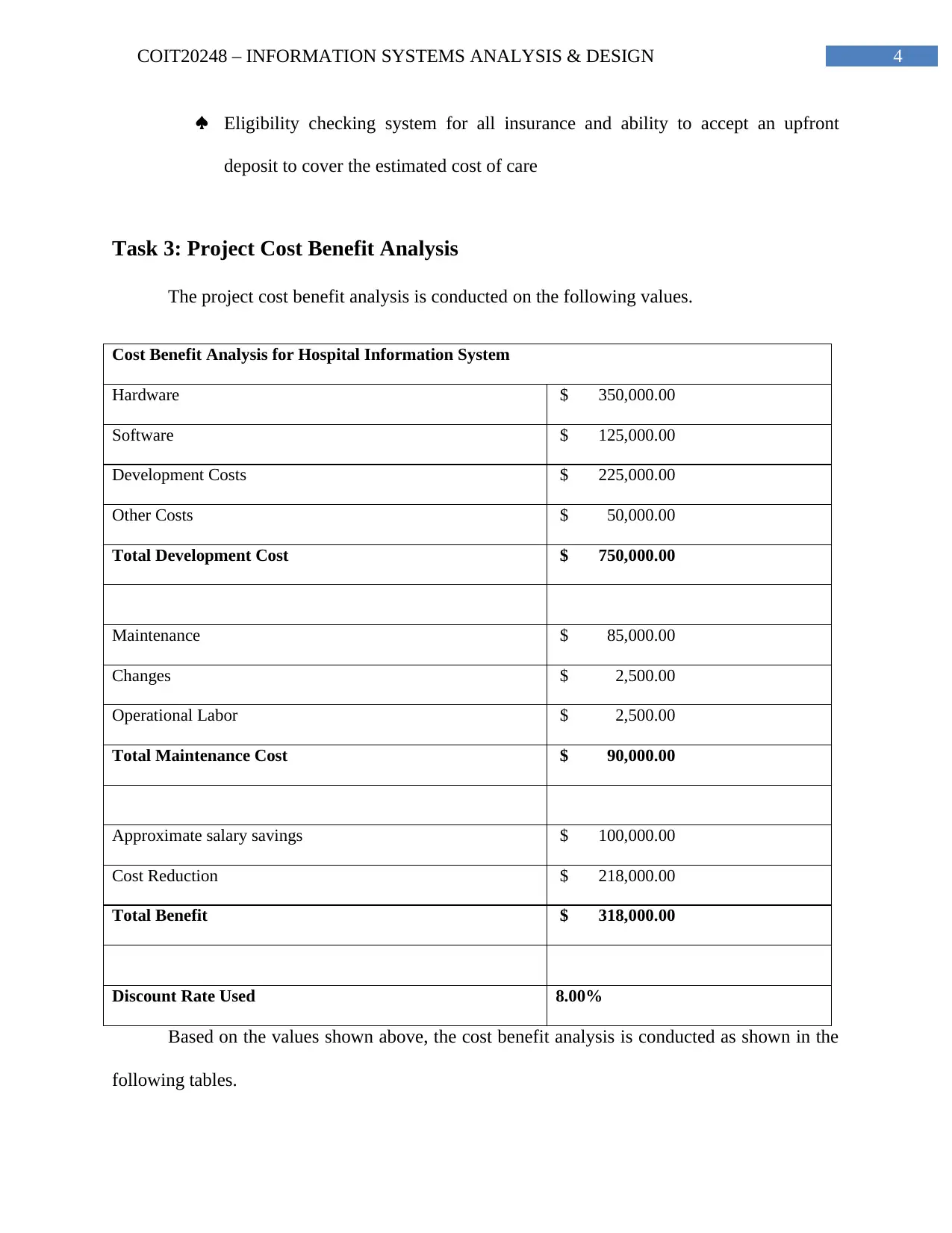
4COIT20248 – INFORMATION SYSTEMS ANALYSIS & DESIGN
Eligibility checking system for all insurance and ability to accept an upfront
deposit to cover the estimated cost of care
Task 3: Project Cost Benefit Analysis
The project cost benefit analysis is conducted on the following values.
Cost Benefit Analysis for Hospital Information System
Hardware $ 350,000.00
Software $ 125,000.00
Development Costs $ 225,000.00
Other Costs $ 50,000.00
Total Development Cost $ 750,000.00
Maintenance $ 85,000.00
Changes $ 2,500.00
Operational Labor $ 2,500.00
Total Maintenance Cost $ 90,000.00
Approximate salary savings $ 100,000.00
Cost Reduction $ 218,000.00
Total Benefit $ 318,000.00
Discount Rate Used 8.00%
Based on the values shown above, the cost benefit analysis is conducted as shown in the
following tables.
Eligibility checking system for all insurance and ability to accept an upfront
deposit to cover the estimated cost of care
Task 3: Project Cost Benefit Analysis
The project cost benefit analysis is conducted on the following values.
Cost Benefit Analysis for Hospital Information System
Hardware $ 350,000.00
Software $ 125,000.00
Development Costs $ 225,000.00
Other Costs $ 50,000.00
Total Development Cost $ 750,000.00
Maintenance $ 85,000.00
Changes $ 2,500.00
Operational Labor $ 2,500.00
Total Maintenance Cost $ 90,000.00
Approximate salary savings $ 100,000.00
Cost Reduction $ 218,000.00
Total Benefit $ 318,000.00
Discount Rate Used 8.00%
Based on the values shown above, the cost benefit analysis is conducted as shown in the
following tables.
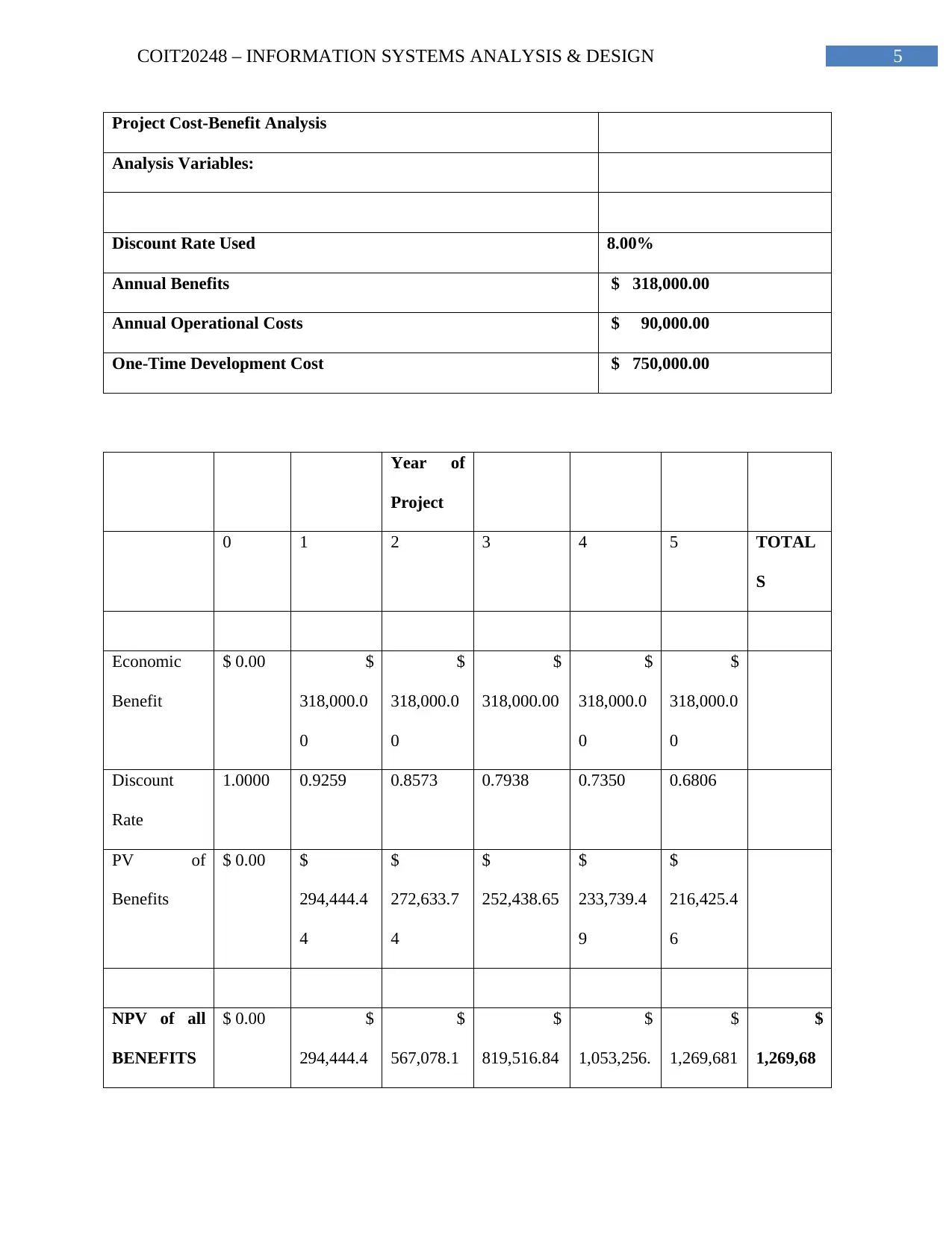
5COIT20248 – INFORMATION SYSTEMS ANALYSIS & DESIGN
Project Cost-Benefit Analysis
Analysis Variables:
Discount Rate Used 8.00%
Annual Benefits $ 318,000.00
Annual Operational Costs $ 90,000.00
One-Time Development Cost $ 750,000.00
Year of
Project
0 1 2 3 4 5 TOTAL
S
Economic
Benefit
$ 0.00 $
318,000.0
0
$
318,000.0
0
$
318,000.00
$
318,000.0
0
$
318,000.0
0
Discount
Rate
1.0000 0.9259 0.8573 0.7938 0.7350 0.6806
PV of
Benefits
$ 0.00 $
294,444.4
4
$
272,633.7
4
$
252,438.65
$
233,739.4
9
$
216,425.4
6
NPV of all
BENEFITS
$ 0.00 $
294,444.4
$
567,078.1
$
819,516.84
$
1,053,256.
$
1,269,681
$
1,269,68
Project Cost-Benefit Analysis
Analysis Variables:
Discount Rate Used 8.00%
Annual Benefits $ 318,000.00
Annual Operational Costs $ 90,000.00
One-Time Development Cost $ 750,000.00
Year of
Project
0 1 2 3 4 5 TOTAL
S
Economic
Benefit
$ 0.00 $
318,000.0
0
$
318,000.0
0
$
318,000.00
$
318,000.0
0
$
318,000.0
0
Discount
Rate
1.0000 0.9259 0.8573 0.7938 0.7350 0.6806
PV of
Benefits
$ 0.00 $
294,444.4
4
$
272,633.7
4
$
252,438.65
$
233,739.4
9
$
216,425.4
6
NPV of all
BENEFITS
$ 0.00 $
294,444.4
$
567,078.1
$
819,516.84
$
1,053,256.
$
1,269,681
$
1,269,68
⊘ This is a preview!⊘
Do you want full access?
Subscribe today to unlock all pages.

Trusted by 1+ million students worldwide
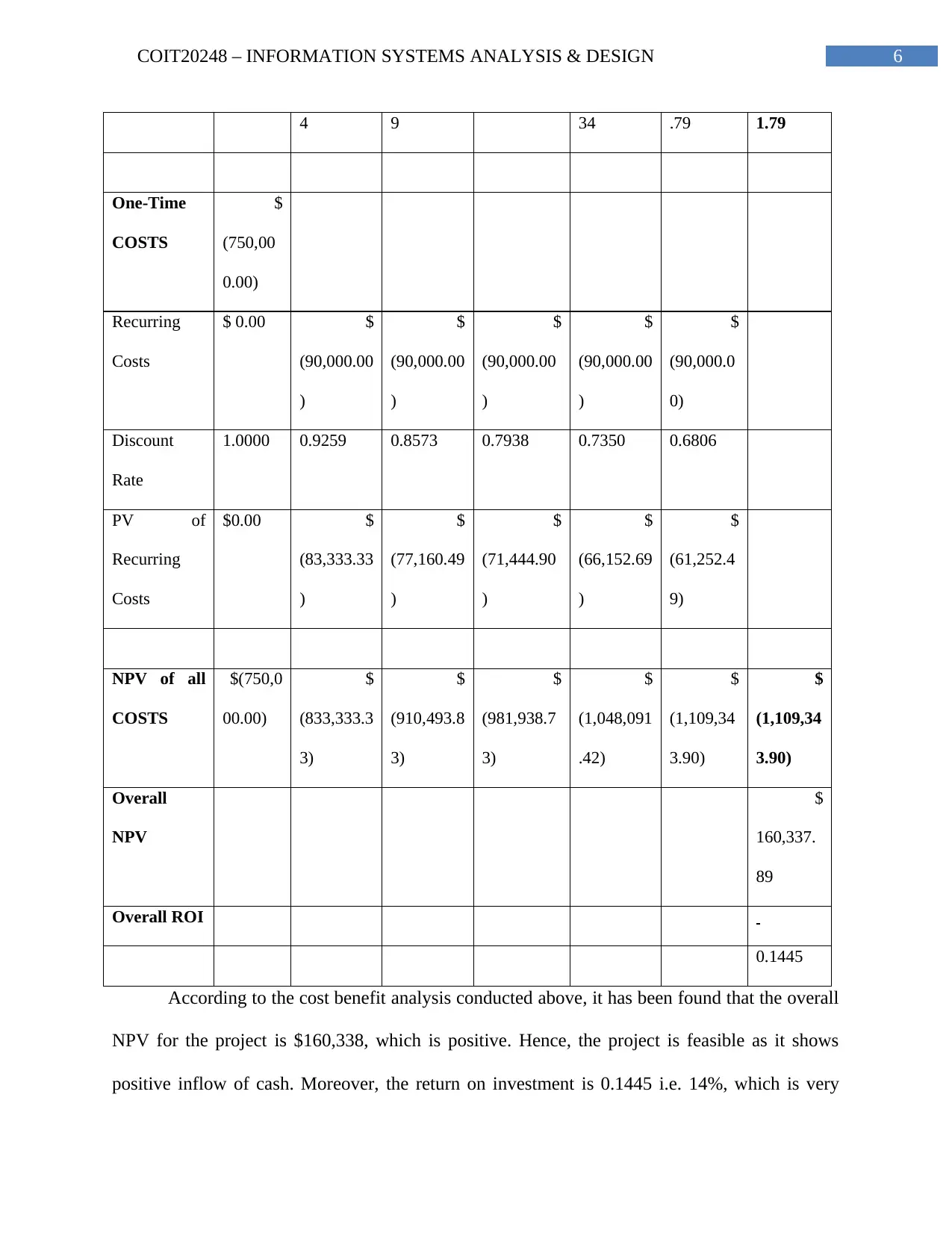
6COIT20248 – INFORMATION SYSTEMS ANALYSIS & DESIGN
4 9 34 .79 1.79
One-Time
COSTS
$
(750,00
0.00)
Recurring
Costs
$ 0.00 $
(90,000.00
)
$
(90,000.00
)
$
(90,000.00
)
$
(90,000.00
)
$
(90,000.0
0)
Discount
Rate
1.0000 0.9259 0.8573 0.7938 0.7350 0.6806
PV of
Recurring
Costs
$0.00 $
(83,333.33
)
$
(77,160.49
)
$
(71,444.90
)
$
(66,152.69
)
$
(61,252.4
9)
NPV of all
COSTS
$(750,0
00.00)
$
(833,333.3
3)
$
(910,493.8
3)
$
(981,938.7
3)
$
(1,048,091
.42)
$
(1,109,34
3.90)
$
(1,109,34
3.90)
Overall
NPV
$
160,337.
89
Overall ROI
0.1445
According to the cost benefit analysis conducted above, it has been found that the overall
NPV for the project is $160,338, which is positive. Hence, the project is feasible as it shows
positive inflow of cash. Moreover, the return on investment is 0.1445 i.e. 14%, which is very
4 9 34 .79 1.79
One-Time
COSTS
$
(750,00
0.00)
Recurring
Costs
$ 0.00 $
(90,000.00
)
$
(90,000.00
)
$
(90,000.00
)
$
(90,000.00
)
$
(90,000.0
0)
Discount
Rate
1.0000 0.9259 0.8573 0.7938 0.7350 0.6806
PV of
Recurring
Costs
$0.00 $
(83,333.33
)
$
(77,160.49
)
$
(71,444.90
)
$
(66,152.69
)
$
(61,252.4
9)
NPV of all
COSTS
$(750,0
00.00)
$
(833,333.3
3)
$
(910,493.8
3)
$
(981,938.7
3)
$
(1,048,091
.42)
$
(1,109,34
3.90)
$
(1,109,34
3.90)
Overall
NPV
$
160,337.
89
Overall ROI
0.1445
According to the cost benefit analysis conducted above, it has been found that the overall
NPV for the project is $160,338, which is positive. Hence, the project is feasible as it shows
positive inflow of cash. Moreover, the return on investment is 0.1445 i.e. 14%, which is very
Paraphrase This Document
Need a fresh take? Get an instant paraphrase of this document with our AI Paraphraser
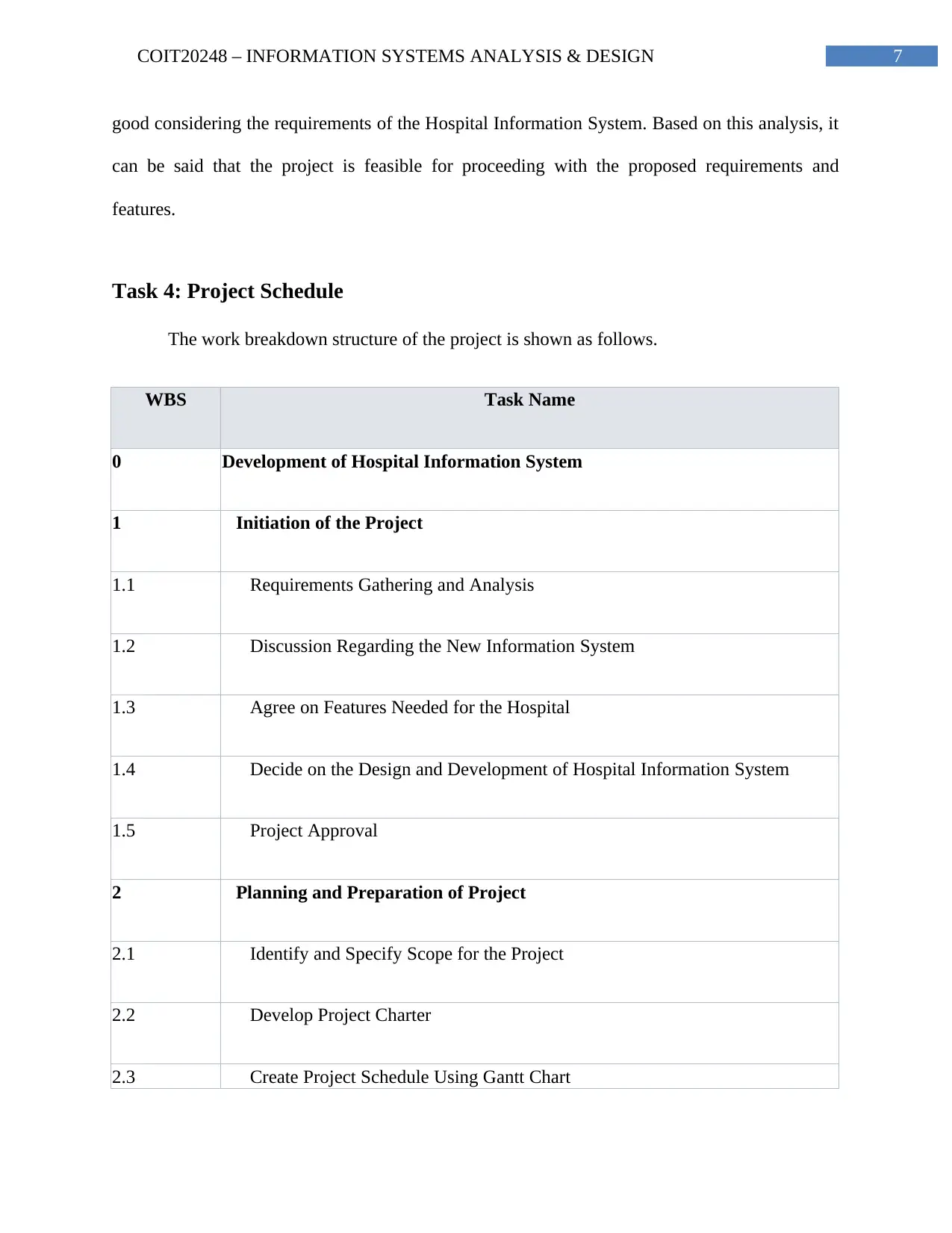
7COIT20248 – INFORMATION SYSTEMS ANALYSIS & DESIGN
good considering the requirements of the Hospital Information System. Based on this analysis, it
can be said that the project is feasible for proceeding with the proposed requirements and
features.
Task 4: Project Schedule
The work breakdown structure of the project is shown as follows.
WBS Task Name
0 Development of Hospital Information System
1 Initiation of the Project
1.1 Requirements Gathering and Analysis
1.2 Discussion Regarding the New Information System
1.3 Agree on Features Needed for the Hospital
1.4 Decide on the Design and Development of Hospital Information System
1.5 Project Approval
2 Planning and Preparation of Project
2.1 Identify and Specify Scope for the Project
2.2 Develop Project Charter
2.3 Create Project Schedule Using Gantt Chart
good considering the requirements of the Hospital Information System. Based on this analysis, it
can be said that the project is feasible for proceeding with the proposed requirements and
features.
Task 4: Project Schedule
The work breakdown structure of the project is shown as follows.
WBS Task Name
0 Development of Hospital Information System
1 Initiation of the Project
1.1 Requirements Gathering and Analysis
1.2 Discussion Regarding the New Information System
1.3 Agree on Features Needed for the Hospital
1.4 Decide on the Design and Development of Hospital Information System
1.5 Project Approval
2 Planning and Preparation of Project
2.1 Identify and Specify Scope for the Project
2.2 Develop Project Charter
2.3 Create Project Schedule Using Gantt Chart
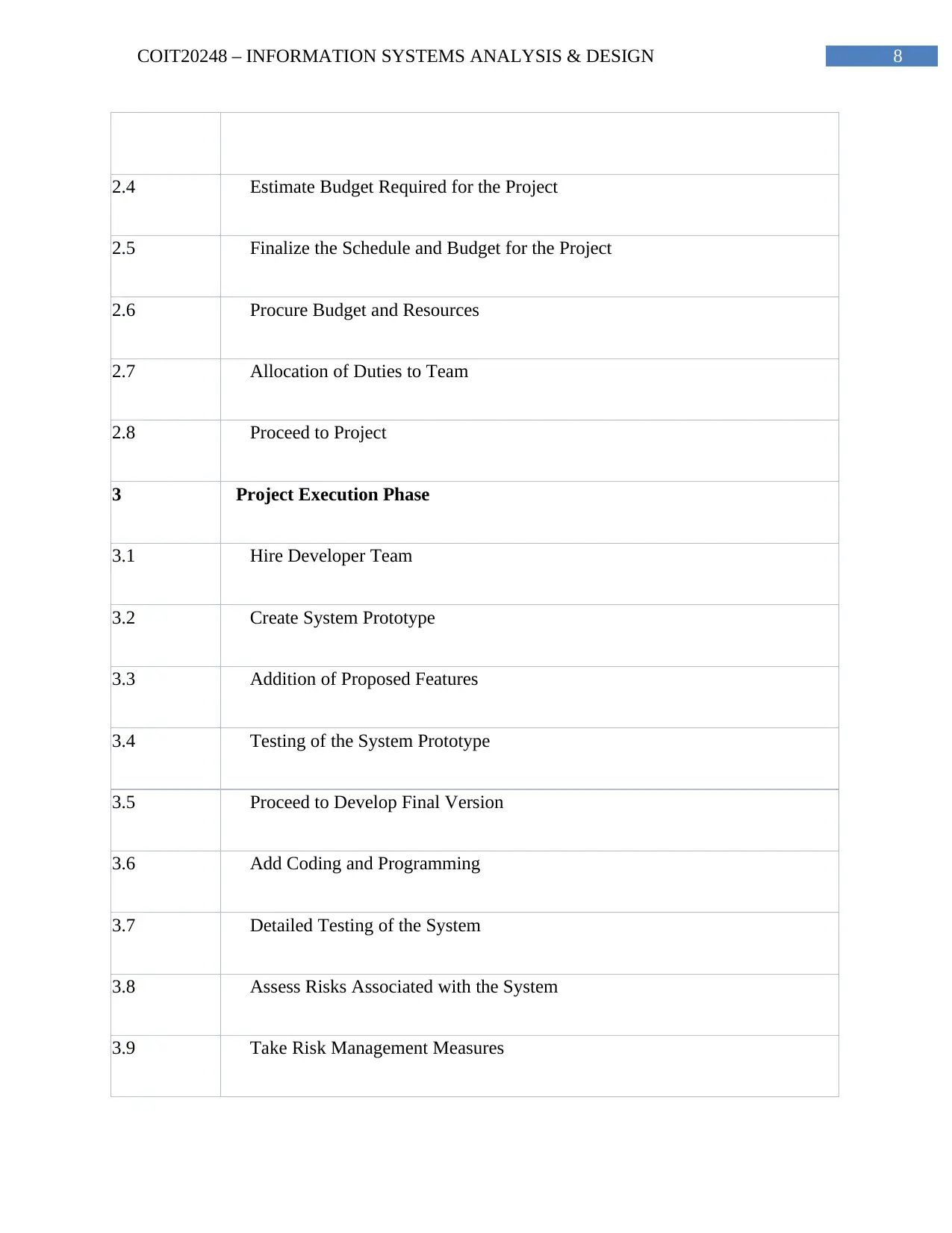
8COIT20248 – INFORMATION SYSTEMS ANALYSIS & DESIGN
2.4 Estimate Budget Required for the Project
2.5 Finalize the Schedule and Budget for the Project
2.6 Procure Budget and Resources
2.7 Allocation of Duties to Team
2.8 Proceed to Project
3 Project Execution Phase
3.1 Hire Developer Team
3.2 Create System Prototype
3.3 Addition of Proposed Features
3.4 Testing of the System Prototype
3.5 Proceed to Develop Final Version
3.6 Add Coding and Programming
3.7 Detailed Testing of the System
3.8 Assess Risks Associated with the System
3.9 Take Risk Management Measures
2.4 Estimate Budget Required for the Project
2.5 Finalize the Schedule and Budget for the Project
2.6 Procure Budget and Resources
2.7 Allocation of Duties to Team
2.8 Proceed to Project
3 Project Execution Phase
3.1 Hire Developer Team
3.2 Create System Prototype
3.3 Addition of Proposed Features
3.4 Testing of the System Prototype
3.5 Proceed to Develop Final Version
3.6 Add Coding and Programming
3.7 Detailed Testing of the System
3.8 Assess Risks Associated with the System
3.9 Take Risk Management Measures
⊘ This is a preview!⊘
Do you want full access?
Subscribe today to unlock all pages.

Trusted by 1+ million students worldwide
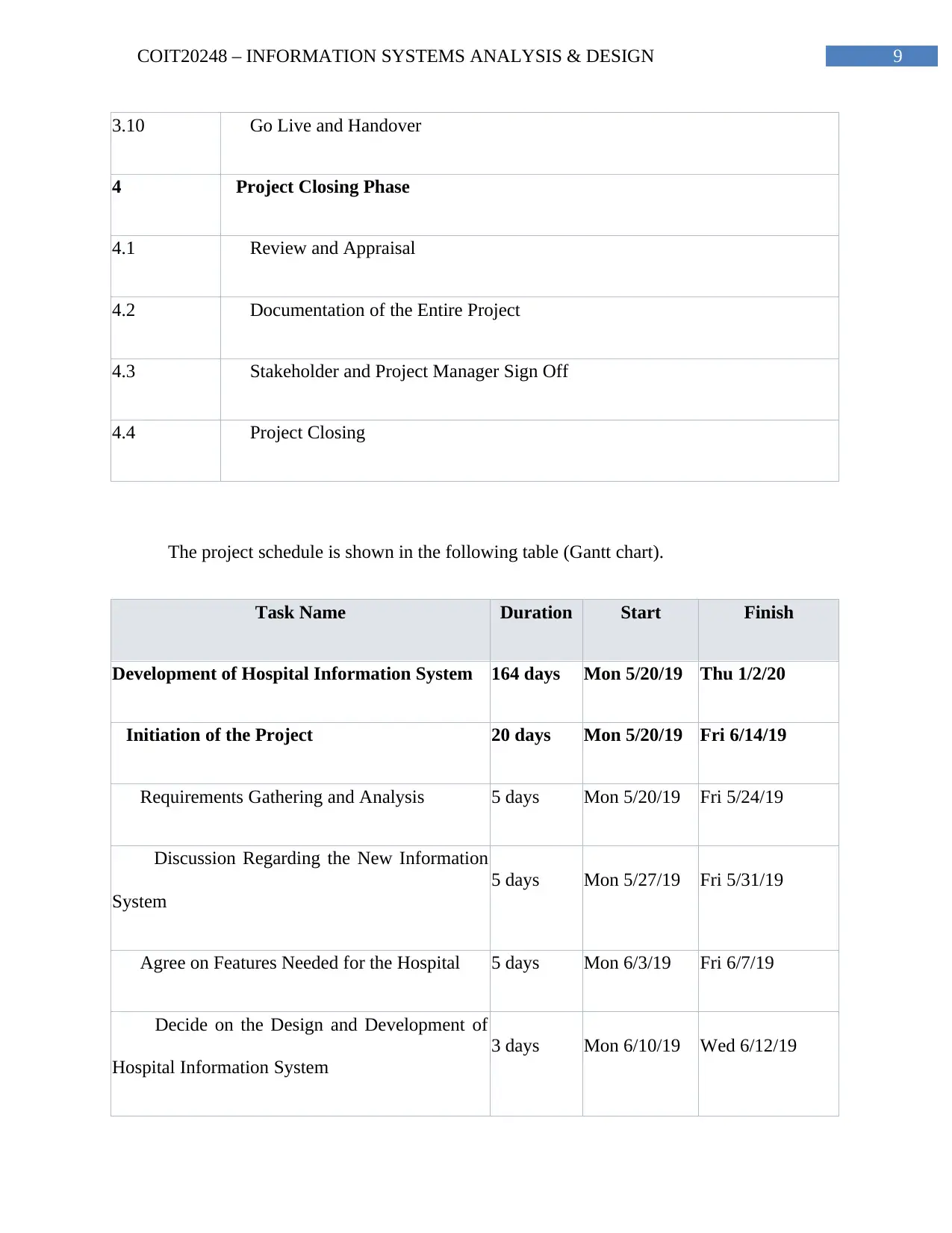
9COIT20248 – INFORMATION SYSTEMS ANALYSIS & DESIGN
3.10 Go Live and Handover
4 Project Closing Phase
4.1 Review and Appraisal
4.2 Documentation of the Entire Project
4.3 Stakeholder and Project Manager Sign Off
4.4 Project Closing
The project schedule is shown in the following table (Gantt chart).
Task Name Duration Start Finish
Development of Hospital Information System 164 days Mon 5/20/19 Thu 1/2/20
Initiation of the Project 20 days Mon 5/20/19 Fri 6/14/19
Requirements Gathering and Analysis 5 days Mon 5/20/19 Fri 5/24/19
Discussion Regarding the New Information
System
5 days Mon 5/27/19 Fri 5/31/19
Agree on Features Needed for the Hospital 5 days Mon 6/3/19 Fri 6/7/19
Decide on the Design and Development of
Hospital Information System
3 days Mon 6/10/19 Wed 6/12/19
3.10 Go Live and Handover
4 Project Closing Phase
4.1 Review and Appraisal
4.2 Documentation of the Entire Project
4.3 Stakeholder and Project Manager Sign Off
4.4 Project Closing
The project schedule is shown in the following table (Gantt chart).
Task Name Duration Start Finish
Development of Hospital Information System 164 days Mon 5/20/19 Thu 1/2/20
Initiation of the Project 20 days Mon 5/20/19 Fri 6/14/19
Requirements Gathering and Analysis 5 days Mon 5/20/19 Fri 5/24/19
Discussion Regarding the New Information
System
5 days Mon 5/27/19 Fri 5/31/19
Agree on Features Needed for the Hospital 5 days Mon 6/3/19 Fri 6/7/19
Decide on the Design and Development of
Hospital Information System
3 days Mon 6/10/19 Wed 6/12/19
Paraphrase This Document
Need a fresh take? Get an instant paraphrase of this document with our AI Paraphraser
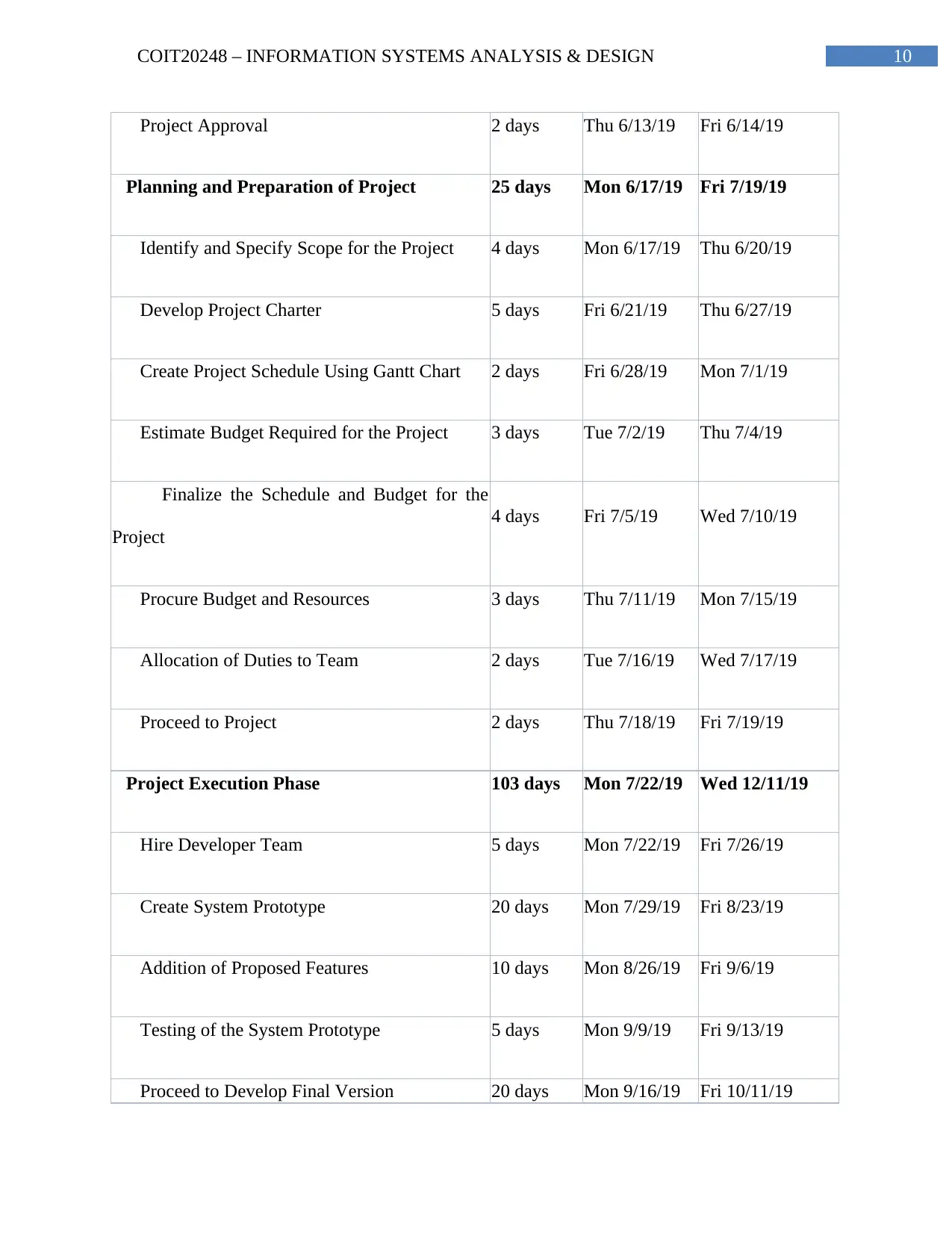
10COIT20248 – INFORMATION SYSTEMS ANALYSIS & DESIGN
Project Approval 2 days Thu 6/13/19 Fri 6/14/19
Planning and Preparation of Project 25 days Mon 6/17/19 Fri 7/19/19
Identify and Specify Scope for the Project 4 days Mon 6/17/19 Thu 6/20/19
Develop Project Charter 5 days Fri 6/21/19 Thu 6/27/19
Create Project Schedule Using Gantt Chart 2 days Fri 6/28/19 Mon 7/1/19
Estimate Budget Required for the Project 3 days Tue 7/2/19 Thu 7/4/19
Finalize the Schedule and Budget for the
Project
4 days Fri 7/5/19 Wed 7/10/19
Procure Budget and Resources 3 days Thu 7/11/19 Mon 7/15/19
Allocation of Duties to Team 2 days Tue 7/16/19 Wed 7/17/19
Proceed to Project 2 days Thu 7/18/19 Fri 7/19/19
Project Execution Phase 103 days Mon 7/22/19 Wed 12/11/19
Hire Developer Team 5 days Mon 7/22/19 Fri 7/26/19
Create System Prototype 20 days Mon 7/29/19 Fri 8/23/19
Addition of Proposed Features 10 days Mon 8/26/19 Fri 9/6/19
Testing of the System Prototype 5 days Mon 9/9/19 Fri 9/13/19
Proceed to Develop Final Version 20 days Mon 9/16/19 Fri 10/11/19
Project Approval 2 days Thu 6/13/19 Fri 6/14/19
Planning and Preparation of Project 25 days Mon 6/17/19 Fri 7/19/19
Identify and Specify Scope for the Project 4 days Mon 6/17/19 Thu 6/20/19
Develop Project Charter 5 days Fri 6/21/19 Thu 6/27/19
Create Project Schedule Using Gantt Chart 2 days Fri 6/28/19 Mon 7/1/19
Estimate Budget Required for the Project 3 days Tue 7/2/19 Thu 7/4/19
Finalize the Schedule and Budget for the
Project
4 days Fri 7/5/19 Wed 7/10/19
Procure Budget and Resources 3 days Thu 7/11/19 Mon 7/15/19
Allocation of Duties to Team 2 days Tue 7/16/19 Wed 7/17/19
Proceed to Project 2 days Thu 7/18/19 Fri 7/19/19
Project Execution Phase 103 days Mon 7/22/19 Wed 12/11/19
Hire Developer Team 5 days Mon 7/22/19 Fri 7/26/19
Create System Prototype 20 days Mon 7/29/19 Fri 8/23/19
Addition of Proposed Features 10 days Mon 8/26/19 Fri 9/6/19
Testing of the System Prototype 5 days Mon 9/9/19 Fri 9/13/19
Proceed to Develop Final Version 20 days Mon 9/16/19 Fri 10/11/19
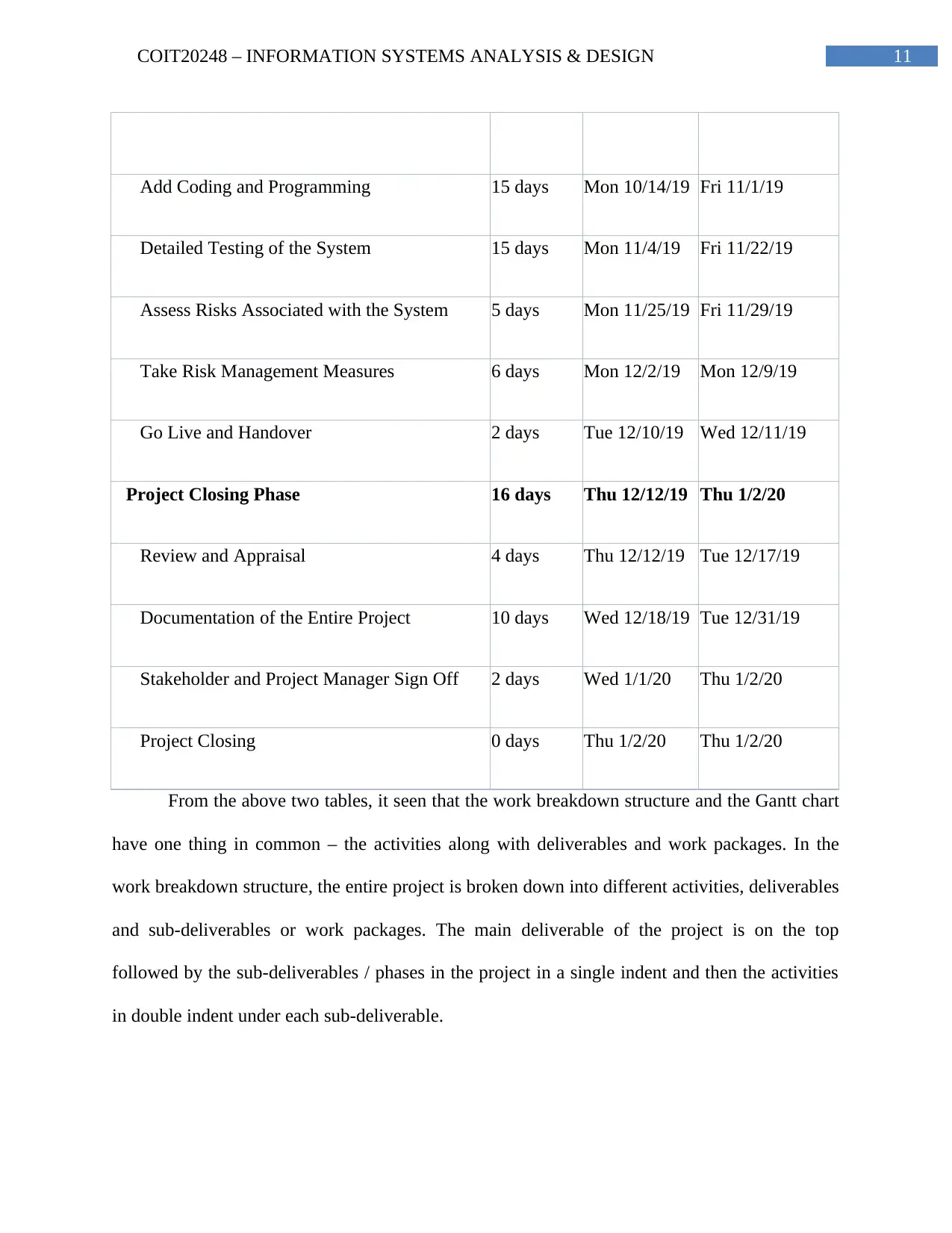
11COIT20248 – INFORMATION SYSTEMS ANALYSIS & DESIGN
Add Coding and Programming 15 days Mon 10/14/19 Fri 11/1/19
Detailed Testing of the System 15 days Mon 11/4/19 Fri 11/22/19
Assess Risks Associated with the System 5 days Mon 11/25/19 Fri 11/29/19
Take Risk Management Measures 6 days Mon 12/2/19 Mon 12/9/19
Go Live and Handover 2 days Tue 12/10/19 Wed 12/11/19
Project Closing Phase 16 days Thu 12/12/19 Thu 1/2/20
Review and Appraisal 4 days Thu 12/12/19 Tue 12/17/19
Documentation of the Entire Project 10 days Wed 12/18/19 Tue 12/31/19
Stakeholder and Project Manager Sign Off 2 days Wed 1/1/20 Thu 1/2/20
Project Closing 0 days Thu 1/2/20 Thu 1/2/20
From the above two tables, it seen that the work breakdown structure and the Gantt chart
have one thing in common – the activities along with deliverables and work packages. In the
work breakdown structure, the entire project is broken down into different activities, deliverables
and sub-deliverables or work packages. The main deliverable of the project is on the top
followed by the sub-deliverables / phases in the project in a single indent and then the activities
in double indent under each sub-deliverable.
Add Coding and Programming 15 days Mon 10/14/19 Fri 11/1/19
Detailed Testing of the System 15 days Mon 11/4/19 Fri 11/22/19
Assess Risks Associated with the System 5 days Mon 11/25/19 Fri 11/29/19
Take Risk Management Measures 6 days Mon 12/2/19 Mon 12/9/19
Go Live and Handover 2 days Tue 12/10/19 Wed 12/11/19
Project Closing Phase 16 days Thu 12/12/19 Thu 1/2/20
Review and Appraisal 4 days Thu 12/12/19 Tue 12/17/19
Documentation of the Entire Project 10 days Wed 12/18/19 Tue 12/31/19
Stakeholder and Project Manager Sign Off 2 days Wed 1/1/20 Thu 1/2/20
Project Closing 0 days Thu 1/2/20 Thu 1/2/20
From the above two tables, it seen that the work breakdown structure and the Gantt chart
have one thing in common – the activities along with deliverables and work packages. In the
work breakdown structure, the entire project is broken down into different activities, deliverables
and sub-deliverables or work packages. The main deliverable of the project is on the top
followed by the sub-deliverables / phases in the project in a single indent and then the activities
in double indent under each sub-deliverable.
⊘ This is a preview!⊘
Do you want full access?
Subscribe today to unlock all pages.

Trusted by 1+ million students worldwide
1 out of 17
Related Documents
Your All-in-One AI-Powered Toolkit for Academic Success.
+13062052269
info@desklib.com
Available 24*7 on WhatsApp / Email
![[object Object]](/_next/static/media/star-bottom.7253800d.svg)
Unlock your academic potential
Copyright © 2020–2025 A2Z Services. All Rights Reserved. Developed and managed by ZUCOL.





